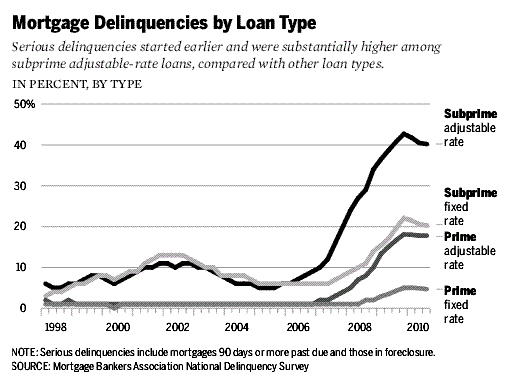
Traditional vs Alternative (Mortgage Products)
What’s The Difference Between The Two?
Most people don’t know the difference between traditional vs alternative (niche) mortgage products when buying or refinancing their home. To some it may seem like common sense, but to others they don’t have a clue. It’s important to know however, the difference between the two if you want a steady mortgage payment for the life of the loan. Let me explain why. You see, after the housing market collapsed in 2008 a lot of people were panicking and losing their homes. They were wondering what was happening and why it happened. It took a while to come up with a few reasons, but it was clear that one thing was certain: subprime alternative and niche products were a major part of the problem. (See chart below).
Before the housing collapse in 2008, now known as the Great Recession, the mortgage products available on the market were to attract anyone wanting t o buy a house or refinance their current home. It didn’t matter what their credit score were, if they had any income, assets, or whether or not they had money to put down. These were subprime clients, and as such, subprime products came into play to help them qualify.
o buy a house or refinance their current home. It didn’t matter what their credit score were, if they had any income, assets, or whether or not they had money to put down. These were subprime clients, and as such, subprime products came into play to help them qualify.
The American Dream Downpayment Act of 2003 signed by former President Bush was a complete disaster. (Click reference). Although he may have had the right intentions, it was not properly executed. Low income earners and anyone for that matter, whether with good or bad credit, were able to qualify to buy a house or refinance their current home up to 100% financed. If they wanted, homeowners could have taken all their money (equity) out of their home on a cash-out refinance and stop making their mortgage payment.
The Problem?
In those days, regulation was very loose, many subprime products were available, and a lot of fraud was lurking along the way. This is what you call “risk layering”, when you have a mix of bad products being used simultaneously. For example, a prospect client could have bought a house 100% financed with stated income, bad credit, and an “interest only” program for the first few years. This was very risky indeed, but it was possible prior to 2008. These products would help borrowers get into a home, but surprise them with a higher mortgage payment at a later time. After the interest only part expired, the full monthly payment with principal and interest would need to be made.
Subprime products were difficult for consumers to keep track of. Most often than not, they were hit with a huge mortgage payment, which they were unable to afford after the rate needed to be adjusted. In addition, the DTI (debt-to-income) ratio was ineffective since the borrower could just do a stated income program. No one properly double checked if the income was accurate or not. A lot of mortgage loan officers failed to regulate these simple fundamental guidelines as well. In the end, people were getting into a mortgage loan they couldn’t really afford and were destined to fail.
Years later, because of these subprime loans, millions of borrowers went into default and were upside down on their mortgage. This scenario times millions of homeowners obviously created a huge negative ripple effect on the whole U.S. and global economy.
Solution:
After the Obama administration took office in 2008, regulators got their act together and lending practice became tighter to clean up the mess left behind by these junk products. The economy and lending practice began to grow steady, stronger, and at a safer rate than before. It improved the lending industry once again, but with much stricter guidelines, which in my opinion, is better for the industry and overall economy.
What we normally tell our clients here at Bonneville Financial Services is that, if you want to stay in your house for a long time, the safest products available on the market is the traditional FHA, VA, or Conventional 30 years fixed loan. That’s the best way to know what your monthly payment will be for the life of the loan without any shocking surprises. These loans are easier to track and are available at a low rate that won’t break the bank. Alternative products nowadays are much safer, but there are still pros and cons. It’s always best to consult with your mortgage loan officer to get some professional advice on what loan to get.
Conclusion:
Next time you’re on the market to buy or refinance your home, consider the traditional (Most Popular) products, it’s the safest way to keep track of your monthly mortgage payment and will surely not disappoint with your financial goals. Since we never know what the future holds, it’s always better to play it safe than to fall into a financial trap.
